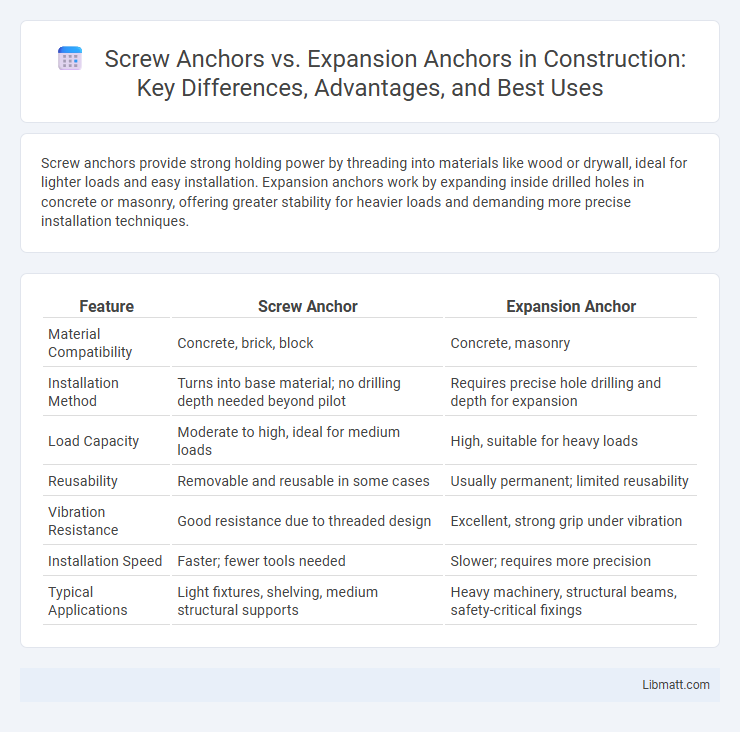Screw anchors provide strong holding power by threading into materials like wood or drywall, ideal for lighter loads and easy installation. Expansion anchors work by expanding inside drilled holes in concrete or masonry, offering greater stability for heavier loads and demanding more precise installation techniques.
Table of Comparison
| Feature | Screw Anchor | Expansion Anchor |
|---|---|---|
| Material Compatibility | Concrete, brick, block | Concrete, masonry |
| Installation Method | Turns into base material; no drilling depth needed beyond pilot | Requires precise hole drilling and depth for expansion |
| Load Capacity | Moderate to high, ideal for medium loads | High, suitable for heavy loads |
| Reusability | Removable and reusable in some cases | Usually permanent; limited reusability |
| Vibration Resistance | Good resistance due to threaded design | Excellent, strong grip under vibration |
| Installation Speed | Faster; fewer tools needed | Slower; requires more precision |
| Typical Applications | Light fixtures, shelving, medium structural supports | Heavy machinery, structural beams, safety-critical fixings |
Introduction to Screw Anchors and Expansion Anchors
Screw anchors provide a versatile fastening solution by drilling directly into materials, creating strong holding power through their threaded design. Expansion anchors, on the other hand, work by expanding inside a pre-drilled hole to securely grip the surrounding substrate, making them ideal for heavy-duty applications. Your choice between these anchors depends on the material, load requirements, and installation environment to ensure maximum stability and safety.
How Screw Anchors Work
Screw anchors function by twisting into a pre-drilled hole in the base material, where their threaded body grips tightly to provide strong holding power. As the anchor is screwed in, the threads engage with the surrounding material, distributing load evenly and preventing pullout. Unlike expansion anchors, screw anchors do not rely on outward pressure to grip but create secure attachment through their helical thread design.
How Expansion Anchors Function
Expansion anchors function by inserting into a drilled hole where they expand against the walls as a bolt or screw is tightened, creating a secure hold in concrete, brick, or stone. The expanding mechanism increases friction and mechanical interlock, distributing the load evenly and preventing pullout. Your choice between screw anchors and expansion anchors depends on the base material and required holding strength.
Material Compatibility for Both Anchor Types
Screw anchors, typically made of zinc-plated steel or stainless steel, offer excellent compatibility with softer materials like wood and drywall, providing firm grip without causing significant damage. Expansion anchors, often constructed from plastic or metal alloys, perform best in solid materials such as concrete, brick, or stone, where their design allows them to expand securely within the substrate. Understanding material compatibility ensures Your anchoring solution provides optimal strength and reliability for the intended surface.
Load Capacity Comparison
Screw anchors generally offer higher load capacity in lighter to medium-duty applications due to their deep thread engagement and material displacement design. Expansion anchors provide superior load capacity in heavy-duty applications, particularly in solid concrete, by expanding to create a secure mechanical interlock. Your choice depends on the substrate strength and the specific load requirements for optimal performance.
Installation Process: Step-by-Step
To install a screw anchor, first drill a pilot hole matching the anchor's diameter, then insert the anchor into the hole and use a screwdriver or drill to drive the screw anchor until it is flush with the surface. For an expansion anchor, start by drilling a hole slightly larger than the anchor body, clean out debris, insert the expansion anchor into the hole, and tighten the bolt or screw to cause the anchor to expand and grip the surrounding material securely. Both installation processes require proper hole sizing and surface preparation to ensure maximum holding strength and stability.
Performance in Different Environments
Screw anchors provide superior performance in softer materials like drywall and wood, offering easy installation and secure holding power in indoor environments. Expansion anchors excel in solid substrates such as concrete and masonry, delivering high load capacity and resistance to vibrations in outdoor and heavy-duty applications. Both anchors vary in corrosion resistance, with stainless steel options enhancing durability in moist or corrosive environments.
Pros and Cons of Screw Anchors
Screw anchors provide excellent holding power in solid materials like concrete and brick, making them ideal for heavy-duty applications where vibration resistance is crucial. They are easy to install without pre-expanding, reducing wall damage and saving time, but they can be less effective in soft or hollow substrates compared to expansion anchors. Your choice should weigh the need for high load capacity against the type of base material to ensure optimal fastening performance.
Pros and Cons of Expansion Anchors
Expansion anchors offer strong holding power by gripping the base material when expanded, making them ideal for heavy-duty applications in concrete, brick, or stone. Their main advantage lies in their reliable load distribution and resistance to vibration, but they can cause material damage due to the expansion force, limiting use in softer substrates. You should consider that installation requires precise drilling and can be less versatile compared to screw anchors, which allow easier removal and adjustment.
Choosing the Right Anchor for Your Project
Selecting the right anchor depends on the substrate and load requirements, with screw anchors offering superior holding power in solid materials like concrete or brick by cutting threads as they are driven in. Expansion anchors rely on mechanical expansion against the base material and work best in pre-drilled holes, providing reliable anchorage in materials with consistent density. Consider the expected load, environmental conditions, and ease of installation when deciding between screw anchors and expansion anchors for optimal stability and longevity.
Screw anchor vs Expansion anchor Infographic

 libmatt.com
libmatt.com